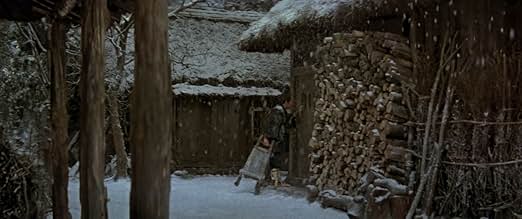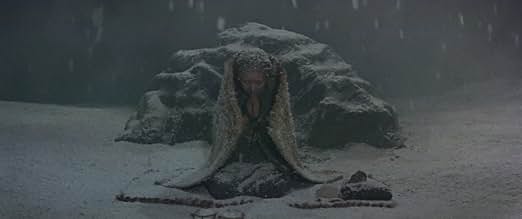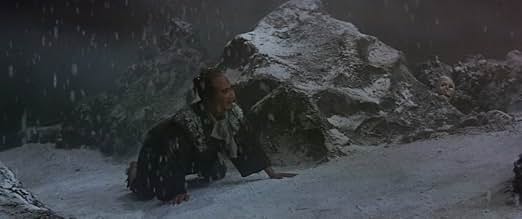IMDb RATING
7.8/10
4K
YOUR RATING
A kabuki theatre-inflected story about a poor village whose people have to be carried to a nearby mountain to die once they get old.A kabuki theatre-inflected story about a poor village whose people have to be carried to a nearby mountain to die once they get old.A kabuki theatre-inflected story about a poor village whose people have to be carried to a nearby mountain to die once they get old.
- Director
- Writers
- Stars
- Awards
- 6 wins & 1 nomination total
- Director
- Writers
- All cast & crew
- Production, box office & more at IMDbPro
Featured reviews
The Ballad of Narayama (1958)
Rating: (4/5)
Review: "The Ballad of Narayama" masterfully blends Kabuki theater with the golden age of Japanese cinema, delivering a powerful and moving experience. The film's fantastic sets and heartrending climax make it truly memorable.
At the heart of the story is Orin, an elderly woman who faces the traditional practice of being carried to Mount Narayama to die once she reaches the age of 70. Her character is portrayed with deep emotional resonance, capturing the strength and dignity with which she accepts her fate. Orin's son plays a crucial role in the narrative, as he struggles with the impending loss of his mother and the cultural expectations placed upon him. Their relationship adds a poignant layer to the film, highlighting themes of familial duty and love.
The performances are deeply emotional, and the direction is impeccable, capturing the cultural and historical essence of the story. This film is a testament to the enduring power of traditional Japanese storytelling.
At the heart of the story is Orin, an elderly woman who faces the traditional practice of being carried to Mount Narayama to die once she reaches the age of 70. Her character is portrayed with deep emotional resonance, capturing the strength and dignity with which she accepts her fate. Orin's son plays a crucial role in the narrative, as he struggles with the impending loss of his mother and the cultural expectations placed upon him. Their relationship adds a poignant layer to the film, highlighting themes of familial duty and love.
The performances are deeply emotional, and the direction is impeccable, capturing the cultural and historical essence of the story. This film is a testament to the enduring power of traditional Japanese storytelling.
It gets a little tedious to relate current events to old movies so apologies dear reader, but while watching this film I couldn't help but think of the heartless voices in American politics that suggested old people sacrifice themselves for the good of the economy during the pandemic this year. It also made me think of Make Way for Tomorrow (1937) and Midsommar (2019), and maybe that's all you need to know (and then some).
Bless the little old lady at its center (Kinuyo Tanaka) - she's so sweet, and certainly contributes to the family by catching fish, hauling the harvest, and cooking, which makes her treatment even more heartbreaking. Whether the practice of obasute is legendary or not, it's easy to see a real-world parallel to how older people are too often forgotten, shoved aside, or abused, which may touch some painful chords in the viewer.
Here we see cruelty that is at times blunt (her annoying-as-hell grandson), ritualized (perhaps to help rationalize it), and in some sense born out of brutal economic need (food is a luxury, and making white rice once a year is a special treat). It all reflects losing our humanity with how we treat the elderly. The film lags a little bit in its last half hour, but it absolutely brims with emotion. The kabuki styling of the storytelling from director Keisuke Kinoshita is delightful, and made me think of our painful little lives as on the stage, each in one role today, and another tomorrow.
Bless the little old lady at its center (Kinuyo Tanaka) - she's so sweet, and certainly contributes to the family by catching fish, hauling the harvest, and cooking, which makes her treatment even more heartbreaking. Whether the practice of obasute is legendary or not, it's easy to see a real-world parallel to how older people are too often forgotten, shoved aside, or abused, which may touch some painful chords in the viewer.
Here we see cruelty that is at times blunt (her annoying-as-hell grandson), ritualized (perhaps to help rationalize it), and in some sense born out of brutal economic need (food is a luxury, and making white rice once a year is a special treat). It all reflects losing our humanity with how we treat the elderly. The film lags a little bit in its last half hour, but it absolutely brims with emotion. The kabuki styling of the storytelling from director Keisuke Kinoshita is delightful, and made me think of our painful little lives as on the stage, each in one role today, and another tomorrow.
In Kabuki style, the film tells the story of a remote mountain village where the scarcity of food leads to a voluntary but socially-enforced policy in which relatives carry 70-year-old family members up Narayama mountain to die.
Roger Ebert of the Chicago Sun-Times rated the film a maximum 4 stars, and added it to his Great Movies list in 2013, making it the final film he added to the list before his death. In a June 1961 review in The New York Times, A.H. Weiler called the film "an odd and colorful evocation of Japan's past that is only occasionally striking"; "It is stylized and occasionally graphic fare in the manner of the Kabuki Theatre, which is realistically staged, but decidedly strange to Western tastes." I have to respectfully disagree with Weiler. Perhaps at the time the film was strange to Western taste. I couldn't speak to that. But I find it quite refreshing, and really enjoy how they made it obvious that the story was told on a stage. Rather than hide the stag as American films do, this one embraces it, so you know you are really watching a story and it need not be any more than that. And yet, it is not just theater but a bigger experience.
Roger Ebert of the Chicago Sun-Times rated the film a maximum 4 stars, and added it to his Great Movies list in 2013, making it the final film he added to the list before his death. In a June 1961 review in The New York Times, A.H. Weiler called the film "an odd and colorful evocation of Japan's past that is only occasionally striking"; "It is stylized and occasionally graphic fare in the manner of the Kabuki Theatre, which is realistically staged, but decidedly strange to Western tastes." I have to respectfully disagree with Weiler. Perhaps at the time the film was strange to Western taste. I couldn't speak to that. But I find it quite refreshing, and really enjoy how they made it obvious that the story was told on a stage. Rather than hide the stag as American films do, this one embraces it, so you know you are really watching a story and it need not be any more than that. And yet, it is not just theater but a bigger experience.
"The balad of Narayama" is about the so called "Ubasute". An elderly person is carried to a mountain and left there to die. According to recent insights "ubasute" is an ancient legend and was never a real practice.
Wit an aging population the relevance of this myth is rising also in the Western world, if only as warning againt tensions between the generations. In the Netherlands there were some ugly discussions about elderly people occupying scarce intensive care capacity at the beginning of the Covid pandemic.
The 1958 version of "The balad of Narayama" is less well known as the movie of the same name by Shohei Imamura from 1983. It differs in two respects.
In the first place there is a material difference. In this movie the center of gravity is on the different ways that people can handle and accept their own mortality. In the Imamura movie the accent is on the battle between the generations for the scarce food supplies (or scarce health care capacity in my example given anbove).
In the second place there is a stylistic difference. This movie is much more artificial, reminding of the traditional Japanese Kabuki drama. In its artificiality of the use of colors it also reminds of "Kwaidan" (1964, Masaki Kobayashi).
I like the version of Keisuke Kinoshita better then the later one of Shohei Imamura. The reason being, I think, that the stylistic artificiality is better suited for the mythical character of the story.
Wit an aging population the relevance of this myth is rising also in the Western world, if only as warning againt tensions between the generations. In the Netherlands there were some ugly discussions about elderly people occupying scarce intensive care capacity at the beginning of the Covid pandemic.
The 1958 version of "The balad of Narayama" is less well known as the movie of the same name by Shohei Imamura from 1983. It differs in two respects.
In the first place there is a material difference. In this movie the center of gravity is on the different ways that people can handle and accept their own mortality. In the Imamura movie the accent is on the battle between the generations for the scarce food supplies (or scarce health care capacity in my example given anbove).
In the second place there is a stylistic difference. This movie is much more artificial, reminding of the traditional Japanese Kabuki drama. In its artificiality of the use of colors it also reminds of "Kwaidan" (1964, Masaki Kobayashi).
I like the version of Keisuke Kinoshita better then the later one of Shohei Imamura. The reason being, I think, that the stylistic artificiality is better suited for the mythical character of the story.
One of the most fascinating books I've read in recent years is Sherwin Nuland's How We Die. In it he relates the exact physical progression of major diseases. But something that fascinates me even more is how our frame of mind changes our perception. I can think of no better example in the realm of death and dying than this ancient tale of 'going up the mountain to die.' Set in an indeterminate time in old Japan, Ballad of Narayama chronicles two elderly people's preparations for death. One of them is Orin. She is a grandmother calmly facing what lies ahead, and putting her affairs (especially those of her family and how they will cope with her dying) into some sort of harmonious picture, so she doesn't have to worry about them. Her neighbour, a man of similar age, is dreading it.
We should maybe bear in mind that a strong spirit of empathy pervades Japanese society, more so than in the West. Human relations are very closely knit and there is much less drive for individualism and autonomy than in the West. Community traditions can play a very big part. And the tradition in the village where these people live is that when people reach a certain age they go up the mountain and die.
Orin takes delight in the 'glowing crimson of the autumn maple.' She has an almost non-theistic spirituality, an idealism and altruism towards others, as well as a humility about her own readiness for death. On the one hand, she says, "The sooner I go, the more the gods will favour me." But she is strangely ashamed of having a full set of teeth. She feels it would be more proper to go to her death as a toothless hag.
If you are spiritually minded, it is quite easy to say that she is in tune with her Shinto or Buddhist beliefs. But if we look at her psychology she has created a world for herself that is filled with attitudes that make her feel good about herself. The thought of her 'pilgrimage' to Narayama fills her with poetic ideas, even if she has no illusions about suffering.
The elderly man on the other hand, clings to his life. He is so obnoxious that his family react badly. They eventually refuse to feed him. "Instead of suffering so, go to Narayama," Orin bids him. "Narayama is the abode of the gods, a place of bliss and blessings." Although it is physically the same place for both of them, it is in effect a very different place for Orin because of her frame of mind. I think the lack of overt religiosity in the film emphasises this. Religion, for those that like it, simply makes, we could say, a ready made poem for us to fit into. Of course, forcing the old man up the hill is a pretty heinous act - and one that the film does not shirk from dealing with.
Often when we watch a film, we want to get submerged in the 'story.' But this can deflect from considering the point that the artist wants to make. The playwright Bertolt Brecht understood this and developed many of his influential theories after watching Japanese theatre. Borrowing from the Kabuki tradition, Ballad of Narayama distances the viewer from the story by creating a very theatrical effect. At the same time, various devices are used to make sure we remain gripped and pay attention.
The film is accompanied by expository chants of a 'jyuri' narrator. There is frequently an unashamed and flamboyant staginess. For instance, a silk backdrop is loosed to reveal a forest at night. What might be considered silly in western cinema works with a Shakespearean majesty here. The film is visually and musically arresting. It doesn't rely on 'realism' to create an effect. We start thinking about the mental states and moral dilemmas of what is patently a modern fairy tale rather than just entertainment.
At the end of the film, a sudden switch to non-theatrical black and white has a disappearing train and a station called 'The Abandoning Place.'
We should maybe bear in mind that a strong spirit of empathy pervades Japanese society, more so than in the West. Human relations are very closely knit and there is much less drive for individualism and autonomy than in the West. Community traditions can play a very big part. And the tradition in the village where these people live is that when people reach a certain age they go up the mountain and die.
Orin takes delight in the 'glowing crimson of the autumn maple.' She has an almost non-theistic spirituality, an idealism and altruism towards others, as well as a humility about her own readiness for death. On the one hand, she says, "The sooner I go, the more the gods will favour me." But she is strangely ashamed of having a full set of teeth. She feels it would be more proper to go to her death as a toothless hag.
If you are spiritually minded, it is quite easy to say that she is in tune with her Shinto or Buddhist beliefs. But if we look at her psychology she has created a world for herself that is filled with attitudes that make her feel good about herself. The thought of her 'pilgrimage' to Narayama fills her with poetic ideas, even if she has no illusions about suffering.
The elderly man on the other hand, clings to his life. He is so obnoxious that his family react badly. They eventually refuse to feed him. "Instead of suffering so, go to Narayama," Orin bids him. "Narayama is the abode of the gods, a place of bliss and blessings." Although it is physically the same place for both of them, it is in effect a very different place for Orin because of her frame of mind. I think the lack of overt religiosity in the film emphasises this. Religion, for those that like it, simply makes, we could say, a ready made poem for us to fit into. Of course, forcing the old man up the hill is a pretty heinous act - and one that the film does not shirk from dealing with.
Often when we watch a film, we want to get submerged in the 'story.' But this can deflect from considering the point that the artist wants to make. The playwright Bertolt Brecht understood this and developed many of his influential theories after watching Japanese theatre. Borrowing from the Kabuki tradition, Ballad of Narayama distances the viewer from the story by creating a very theatrical effect. At the same time, various devices are used to make sure we remain gripped and pay attention.
The film is accompanied by expository chants of a 'jyuri' narrator. There is frequently an unashamed and flamboyant staginess. For instance, a silk backdrop is loosed to reveal a forest at night. What might be considered silly in western cinema works with a Shakespearean majesty here. The film is visually and musically arresting. It doesn't rely on 'realism' to create an effect. We start thinking about the mental states and moral dilemmas of what is patently a modern fairy tale rather than just entertainment.
At the end of the film, a sudden switch to non-theatrical black and white has a disappearing train and a station called 'The Abandoning Place.'
Did you know
- TriviaThis was the final film to be added to Roger Ebert's list of "Great Movies" before his death on April 4, 2013 at the age of 70.
- ConnectionsFeatured in Tvennesnack: Varför kan vi inte komma ihåg den här jävla filmen? (2022)
- How long is The Ballad of Narayama?Powered by Alexa
Details
- Release date
- Country of origin
- Language
- Also known as
- The Ballad of Narayama
- Filming locations
- Production company
- See more company credits at IMDbPro
Contribute to this page
Suggest an edit or add missing content





























